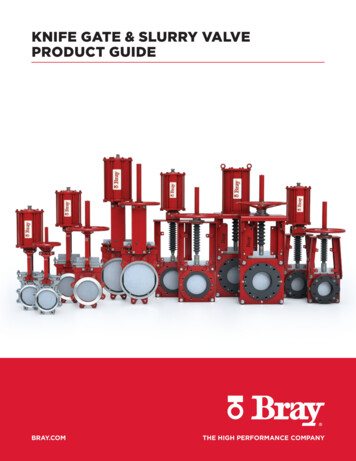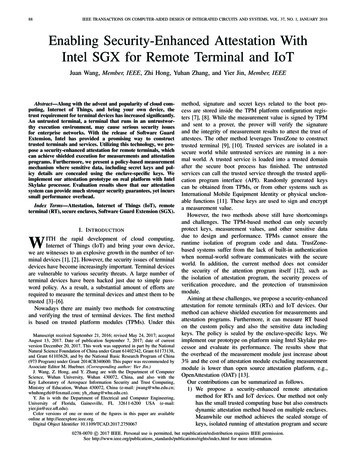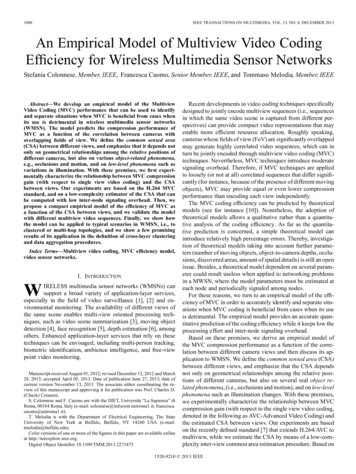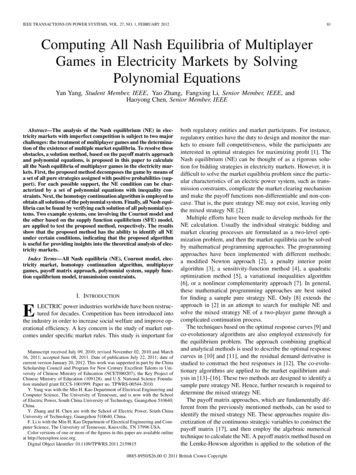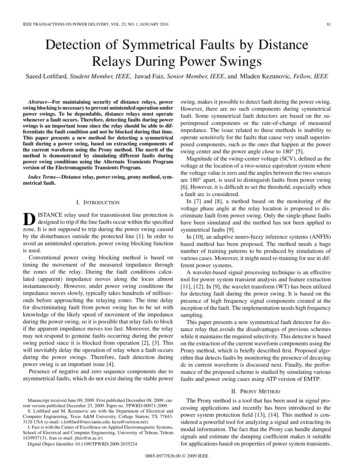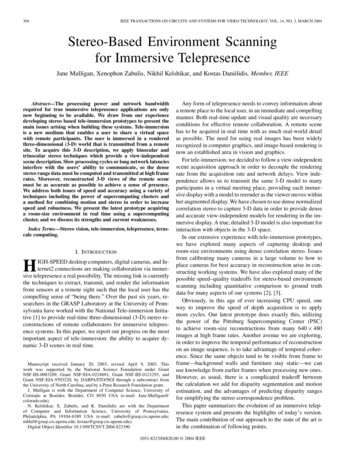
Transcription
304IEEE TRANSACTIONS ON CIRCUITS AND SYSTEMS FOR VIDEO TECHNOLOGY, VOL. 14, NO. 3, MARCH 2004Stereo-Based Environment Scanningfor Immersive TelepresenceJane Mulligan, Xenophon Zabulis, Nikhil Kelshikar, and Kostas Daniilidis, Member, IEEEAbstract—The processing power and network bandwidthrequired for true immersive telepresence applications are onlynow beginning to be available. We draw from our experiencedeveloping stereo based tele-immersion prototypes to present themain issues arising when building these systems. Tele-immersionis a new medium that enables a user to share a virtual spacewith remote participants. The user is immersed in a renderedthree-dimensional (3-D) world that is transmitted from a remotesite. To acquire this 3-D description, we apply binocular andtrinocular stereo techniques which provide a view-independentscene description. Slow processing cycles or long network latenciesinterfere with the users’ ability to communicate, so the densestereo range data must be computed and transmitted at high framerates. Moreover, reconstructed 3-D views of the remote scenemust be as accurate as possible to achieve a sense of presence.We address both issues of speed and accuracy using a variety oftechniques including the power of supercomputing clusters anda method for combining motion and stereo in order to increasespeed and robustness. We present the latest prototype acquiringa room-size environment in real time using a supercomputingcluster, and we discuss its strengths and current weaknesses.Index Terms—Stereo vision, tele-immersion, telepresence, terascale computing.I. INTRODUCTIONHIGH-SPEED desktop computers, digital cameras, and Internet2 connections are making collaboration via immersive telepresence a real possibility. The missing link is currentlythe techniques to extract, transmit, and render the informationfrom sensors at a remote sight such that the local user has thecompelling sense of “being there.” Over the past six years, researchers in the GRASP Laboratory at the University of Pennsylvania have worked with the National Tele-immersion Initiative [1] to provide real-time three-dimensional (3-D) stereo reconstructions of remote collaborators for immersive telepresence systems. In this paper, we report our progress on the mostimportant aspect of tele-immersion: the ability to acquire dynamic 3-D scenes in real time.Manuscript received January 20, 2003; revised April 9, 2003. Thiswork was supported by the National Science Foundation under GrantNSF-IIS-0083209, Grant NSF-EIA-0218691, Grant NSF-IIS-0121293, andGrant NSF-EIA-9703220, by DARPA/ITO/NGI through a subcontract fromthe University of North Carolina, and by a Penn Research Foundation grant.J. Mulligan is with the Department of Computer Science, University ofColorado at Boulder, Boulder, CO 8030 USA (e-mail: Jane.Mulligan@colorado.edu).N. Kelshikar, X. Zabulis, and K. Daniilidis are with the Departmentof Computer and Information Science, University of Pennsylvania,Philadelphia, PA 19104-6389 USA (e-mail: .edu; kostas@grasp.cis.upenn.edu).Digital Object Identifier 10.1109/TCSVT.2004.823390Any form of telepresence needs to convey information abouta remote place to the local user, in an immediate and compellingmanner. Both real-time update and visual quality are necessaryconditions for effective remote collaboration. A remote scenehas to be acquired in real time with as much real-world detailas possible. The need for using real images has been widelyrecognized in computer graphics, and image-based rendering isnow an established area in vision and graphics.For tele-immersion, we decided to follow a view-independentscene acquisition approach in order to decouple the renderingrate from the acquisition rate and network delays. View independence allows us to transmit the same 3-D model to manyparticipants in a virtual meeting place, providing each immersive display with a model to rerender as the viewer moves withinher augmented display. We have chosen to use dense normalizedcorrelation stereo to capture 3-D data in order to provide denseand accurate view-independent models for rendering in the immersive display. A true, detailed 3-D model is also important forinteraction with objects in the 3-D space.In our extensive experience with tele-immersion prototypes,we have explored many aspects of capturing desktop androom-size environments using dense correlation stereo. Issuesfrom calibrating many cameras in a large volume to how toplace cameras for best accuracy in reconstruction arise in constructing working systems. We have also explored many of thepossible speed–quality tradeoffs for stereo-based environmentscanning including quantitative comparison to ground truthdata for many aspects of our systems [2], [3].Obviously, in this age of ever increasing CPU speed, oneway to improve the speed of depth acquisition is to applymore cycles. Our latest prototype does exactly this, utilizingthe power of the Pittsburg Supercomputing Center (PSC)to achieve room-size reconstructions from many 640 480images at high frame rates. Another avenue we are exploring,in order to improve the temporal performance of reconstructionon an image sequence, is to take advantage of temporal coherence. Since the same objects tend to be visible from frame toframe—background walls and furniture stay static—we canuse knowledge from earlier frames when processing new ones.However, as usual, there is a complicated tradeoff betweenthe calculation we add for disparity segmentation and motionestimation, and the advantages of predicting disparity rangesfor simplifying the stereo correspondence problem.This paper summarizes the evolution of an immersive telepresence system and presents the highlights of today’s version.The main contribution of our approach to the state of the art isin the combination of following points.1051-8215/04 20.00 2004 IEEE
MULLIGAN et al.: STEREO-BASED ENVIRONMENT SCANNING FOR IMMERSIVE TELEPRESENCE It is the first integrated 3-D remote telepresence systemcomprising geographically distributed image acquisition,3-D computation, and display. It is the first stereo system that works in a wide areawithout any background subtraction, implemented in realtime using a supercomputer. We propose a temporal prediction process which decreases disparity search range on segmented imageregions for faster stereo correspondence.The remainder of the paper is organized as follows: We continue this section with an overview of telepresence, underlyingchallenges in acquisition, and related systems. In Section II, wereview the evolution of our working tele-immersion prototypes.In Section III, we present the details of our stereo algorithm. InSection IV, we describe an experimental evaluation focusing onthe effects of kernel size and view misregistration. In Section V,we propose prediction and motion-depth modeling to optimizethe disparity range search.A. Telepresence SystemsTelepresence systems can generally be viewed as composedof three parts: a capture system to record and represent the information from the remote site, a network transmission system,and a display system to make the local user feel as if she weresomehow present in the remote scene. These three parts becomeeven more challenging if we require telepresence to be immersive, which means to create the illusion of being in an environment different than the viewer’s true physical surroundings.The first question is, how do we capture representations of theremote scene that are adequate for the task of creating a believable remote presence? We have chosen view-independent 3-Dacquisition with correlation-based stereo because it is fast andnoninvasive. The representation has to be view-independent sothat rendering can be decoupled and thus asynchronous to acquisition. A second advantage of view independence is that an acquired 3-D representation can be broadcast to several receivers.In contrast, a view-dependent approach requires either sendingall images to the remote site where the novel view is computedor computing views locally and transmitting them. In the lattercase, receiving feedback about the user’s head position throughthe network would cause an unmitigated latency.There are two alternative approaches in remote immersiontechnologies we did not follow. The first involves video conferencing in the large: surround projection of two-dimensional(2-D) panoramic images. This requires only a correct alignmentof several views, but lacks the sense of depth and practically forbids any 3-D interaction with virtual/real objects. The secondtechnology [4] uses 3-D graphical descriptions of the remoteparticipants (avatars). This is just another view of the model-freeversus model-based extrema in the 3-D description of scenes orthe bottom-up versus top-down controversy. Assuming that wehave to deal with persons, human models might be applied [5]combined with image-based rendering, but everything in a scenehas to be scanned prior to a telepresence session and fine detail is still missing. Of course, errors in model-based approachestake the form of outlier poses of the avatar, as opposed to outlierdepth points or holes in stereo.305The networking aspects of telepresence systems are just beginning to be defined. If there is communication and interactioninvolved, then latency is the most critical issue. Bandwidth affects the frame arrival rate. If a lossy protocol is applied, weneed techniques to recover from losses, both on the way fromthe cameras to the computing resources as well as on the wayfrom the computing resources to the display. If compression isapplied, then again we need a special image compression on theway from the camera to the computer which minimizes decimation in stereo matching, and another 3-D compression on theway to the display.Finally, regardless of the speed and quality of the data arrivingat the display side, if the local user’s viewing environment is notupdated smoothly and quickly enough by the rendering technologies, she will find even static data jarring to watch. The display system must evoke a compelling sense of presence, thisinvolves real-time head tracking and fast rendering of the 3-Dscene according to the viewer’s head position. In tele-immersion [6], the display used is a spatially augmented display andnot a head-mounted display (HMD), and the rendered components are not prestored perfect virtual objects, but real rangedata acquired online. In addition, these data are transmitted overthe network before being displayed. It is important that the rendering speed be higher than the acquisition speed so that user’sviewpoint changes have a guaranteed refresh response on thescreen.A technically challenging issue is that, for true bidirectionalcommunication, the capture and display sides of the systemmust be collocated. Immersive displays currently have low lightconditions which make the acquisition of quality images fromCCD cameras difficult. Further, the viewer must typically wearpolarized or shutter glasses and possibly a head tracking device which does not give him a particularly natural appearance.From the display point of view, inserting many cameras aroundthe display tends to detract from the compelling 3-D percept.Moving cameras to less obtrusive positions causes their viewpoints to be unaccommodating for reconstruction. To date, wehave not constructed true duplex telecubicles.The final and most important question for telepresence systems is “what defines the sense of presence for users?” Can wemake a telepresence system that is as effective as “being there”?This is more of a psychological question than a technical one,but understanding factors that evoke the human perception ofpresence would allow us to focus our technical resources moreeffectively. The prototypes we describe here offer the first opportunity to perform meaningful psychophysical experiments inorder to discover what can make telepresence effective.B. Related WorkWe have divided our discussion of related work into systemsand algorithms. The most similar immersive telepresencesystem is the 3-D video-conferencing system developed underthe European 5th Framework Programme’s VIRTUE project[7]. Its current version captures a scene with four camerasmounted around a display. After foreground detection andrectification, a block and pixel hierarchic algorithm computesa disparity map while a special depth-segmentation algorithm
306IEEE TRANSACTIONS ON CIRCUITS AND SYSTEMS FOR VIDEO TECHNOLOGY, VOL. 14, NO. 3, MARCH 2004runs for the user’s hands. At the display side, novel viewsof remote conference participants are synthesized. The nextclosest as a system is the Coliseum telepresence system [8]which produces synthetic views using five streams based ona variation of the visual hull method [9]. One of the earliestsuccessful efforts is the Virtualized Reality system at CarnegieMellon University (CMU) [10], [11]. This was first based onmultibaseline dense depth map computation on a specializedarchitecture. More recent versions [12] are based on visual hullcomputation using silhouette carving. Its commercial version,manufactured by Zaxel, is used in a real-world teleconferencing system [13] overlaying remote participants on HMDsfor augmented reality collaboration.In the systems category, we should also mention the first commercial real-time stereo vision products: the triclops and digiclops by Pointgrey Research, the Small Vision System by VidereDesign, Tyzx Inc.’s DeepSea based systems, as well as the Komatsu FZ930 system [14]. These systems are not, however, associated with any telepresence application. With respect to multicamera systems, similar to the latest version of our tele-immersion system, we refer the reader to CMU’s newest 3-D room [12]as well as to the view-dependent visual hull system at MIT [9],the Keck laboratory at the University of Maryland [15], and theArgus system at Duke University [16].Stereo vision has a very long tradition and the interest in fastand dense depth maps has increased recently due to the easeof acquiring video-rate stereo sequences with inexpensive cameras. A recent paper by Scharstein and Szeliski [17] providesan excellent taxonomy of binocular vision systems and a systematic comparative evaluation on benchmark image pairs. Further evaluations with emphasis on matching metrics and discontinuities, respectively, can be found in [18]–[20]. Among thearea-based correlation approaches, the most closely related toour system is Sara’s work [21], the classic real-time implementation of trinocular stereo [22], [23], and the recent improvements on correlation stereo by Hirschmuller et al. [24]. Regarding trinocular stereo vision systems, we refer to the recentlyreported trinocular systems based on dynamic programming in[25] and [26].C. Challenges in 3-D Acquisition Through StereoIn the last section, we described the systems challenges forimmersive telepresence. Here we focus on the methodologicalchallenges in the problem we address: environment scanningusing multiple cameras. It is important to note that there are alsoactive methods of scanning using laser cameras or systems enhanced with structured light. Laser cameras are still very expensive and structured light systems are still immature for motionand arbitrary texture. Nevertheless, the performance of passivetechniques like ours can be improved with projection of unstructured light to complement missing natural texture on surfaces.When using multiple cameras, we have two choices of theworking domain. We can choose either pairs/triples and obtaindepth views from each such cluster or we can work volumetrically where the final result is a set of voxel occupancies.While stereo methods rely on matching, volumetric methodscan reduce matching to photo-consistency or even just usesilhouettes. To date, we have used combinations of pairs/triplesin order to guarantee real-time responsiveness and keep thesystem scalable in the number of depth views. As is widelyknown, stereo is based on correspondence. The number of possible correspondence assignments without any assumption isexponential. There are two main challenges here: nonexistenceof correspondence in case of half-occlusions or specularitiesand nonuniqueness in case of homogeneous (infinite solutions)or periodic (finite countable solutions) texture.All existing real-time stereo methods are greedy algorithmswhich choose the “best” correspondence by considering somefinite neighborhood, but they never backtrack to correct a depthvalue. The match is established by maximizing a correlationmetric, with a subsequent selection of the best match. Overlystrict selection criteria can result in holes (no valid match)which are larger than areas with no texture or very loose criteriacan create multiple outliers (wrong matches). Confidence inour similarity metric is significantly increased if we increasethe size of the correlation kernel, but this creates erroneousresults at half-occlusions, in particular when one of the twoareas in an occlusion does not have significant structure. Themost recent prototype resolves some of the outlier problemsby using large correlation kernels in a binocular algorithm.Our current system constructs multiple depth views, and weapply strict selection criteria because we anticipate that holesat occlusions will be filled by neighboring depth views.This merging of views brings us to the problem of registration of multiple depth views to a common coordinate frame.Calibration of many cameras in a large space is a challengingtask. When using a reference object for calibration, registrationerror grows with distance from the reference object. This meansthat while two depth views are fused correctly when the reconstructed points are close at the location of the reference objectduring calibration, there is a drift between them when the 3-Dpoints are far from that location. The only remedy for misregistration is a unique volumetric search space, which is part of ourongoing research.II. EVOLUTION OF TELE-IMMERSION PROTOTYPESSince our group at the University of Pennsylvania joined theNational Tele-immersion Initiative (NTII), we have participatedin the development of several tele-immersion prototypes. NTIIwas conceived by Advanced Network and Services with the expectation that immersive telepresence applications could be adriving application for the capacity of Internet2.The first working networked tele-immersion prototype (telecubicle) that computed 3-D stereo reconstructions, transmittedthem via TCP/IP, and rendered them in a stereoscopic displaywas demonstrated in May of 1999. The rig is illustrated inFig. 1(a) and included a pair of Sony XC77R cameras (center),and a computer monitor (CRT) capable of generating stereoviews for shutter glasses. Computation was provided by a pairof Pentium 450 PCs, one driving the stereoscopic display andthe other capturing image pairs and generating stereo depthmaps. Binocular correlation stereo was used to generate a cloudof depth points, which could optionally be triangulated usingJonathan Shewhuk’s Triangle code [27]. A rotated triangulateddepth view is illustrated in Fig. 1(b).
MULLIGAN et al.: STEREO-BASED ENVIRONMENT SCANNING FOR IMMERSIVE TELEPRESENCE307Fig. 1. (a) First networked prototype used shutter glasses and a monitor for stereoscopic viewing. (b) Binocular stereo depth maps were triangulated and rendered.Fig. 2.Traffic peaks into the research triangle on May 2000 demo dates.Fig. 3. Working prototypes from May and October 2000. (a) In May, the University of Pennsylvania and advanced network and services each transmitted fivesimultaneous trinocular depth streams to the University of North Carolina Chapel Hill. (b) In October, 3-D interaction and synthetic objects were added to thecollaborative environment.The next milestone in the tele-immersion project occurredin May 2000 at a major collaborative demonstration amongAdvanced Network and Services in Armonk, New York, theUniversity of North Carolina (UNC), Chapel Hill, and theGRASP Lab at the University of Pennsylvania. The majorinnovations for stereo environment scanning were a changefrom binocular to trinocular correspondence, using a suite ofseven Sony DFW-V500 1394 cameras combined in overlappingtriples, background subtraction and parallelization of the stereoimplementation for quad-processor Dell servers. Naturally, theshear volume of computation and data for transmission wasgreatly increased. We achieved our goal of driving Internet2bandwidth as demonstrated by the plot of traffic into theResearch Triangle on the dates of our demo and rehearsals(see Fig. 2).The demo scenario involved transmission of five simultaneous 3-D views per temporal frame from both Advanced andGRASP. These were combined in the sophisticated immersivedisplay provided by UNC. This included two large displayscreens, one for Armonk and one for Philadelphia, each witha pair of projectors providing differently polarized left–rightstereoscopic views. A High-Ball [28] head tracker providedthe viewer’s head position so 3-D views could be rerenderedcorrectly for the user’s viewpoint. The display is illustratedin Fig. 3(a). The camera rig is illustrated in Fig. 5(a) and anexample temporal frame is in Fig. 4. The cameras were arranged at uniform height in an arc in front of the user. Althoughthe correlation metric remained the same, new methods forrectifying the triple as two independent pairs and combiningthe correlation scores for the current depth estimate were
308IEEE TRANSACTIONS ON CIRCUITS AND SYSTEMS FOR VIDEO TECHNOLOGY, VOL. 14, NO. 3, MARCH 2004Fig. 4. Seven camera views.Fig. 5. Seven-camera rig and combined rendered 3-D views.TABLE IPERFORMANCE STATISTICS FOR VERSIONS OF THE TELE-IMMERSION SYSTEMintroduced [29]. A combined rendering of the depth viewsgenerated from the images in Fig. 4 is illustrated in Fig. 5(b).In October of 2000, the next important augmentation of thetele-immersion prototype was demonstrated. Van Dam and hiscolleagues from Brown University integrated 3-D interactionwith the UNC display system [30]. Users could use a magneticpointer to manipulate and create synthetic objects in the shared3-D space. This scenario is illustrated in Fig. 3(b). The stereosystem, with which we are mainly concerned in this paper, remained largely the same except that a simple prediction schemewas added where the disparity search was limited to a restrictedrange centered about the computed disparity for the last frame.Although this seems like a minor alteration, it had a significantimpact on the cycle time of the stereo calculation (see Table I).By just updating the hardware, the same system was running at8 fps in August 2002.The latest collaboration with the UNC and the PSC, funded bythe National Science Foundation (NSF), boosted our computation capabilities and gave us the opportunity to be the first to trya room-size real-time reconstruction. The associated increase inthe number of input streams as well as in disparity range was areal computational challenge. To make computations as parallelas possible, we temporarily returned to the binocular version.However, this increased the presence of outliers and, thus, thekernel size was drastically increased from 5 5 to 31 31. Theeffects of kernel size on reconstruction are discussed in Section IV-B.In November 2002, we achieved a real-time demonstrationof the full cycle at the Supercomputing Conference 2002 inBaltimore. The terascale computing system at the PSC is anHP Alphaserver cluster comprising 750 four-processor computenodes. Since the PSC is at a remote location, we established oneof the first applications where sensing, computation, and displayare at three different sites but coupled in real time. To tackle thetransmission constraints, an initial implementation contains avideo server transmitting TCP/IP video streams and a reliableUDP transmission of the depth maps from the computation tothe display site as shown in Fig. 6. This reliable UDP transmission is implemented by a protocol specifically designed forthis application, called RUDP. This protocol was designed bythe UNC group and provides reliable data transmission requiredby the application without any congestion control, thereby providing better throughput than TCP. The camera cluster and asnapshot of the rendered scene are shown in Fig. 7.The massively parallel architecture operates on images fourtimes the size of those used in previous systems (640 480versus 320 240). Increasing the correlation window sizefrom 5 5 to 31 31 increased computation approximately 36times. However, we used binocular instead of trinocular stereoso the overhead of matching has been reduced. Overall, thenew system requires at least 72 times more computation. Sincewe do not perform background subtraction, it also adds a factorof 3–4 in complexity.The correlation window size is the main parameter affectingperformance. We ran a series of tests to verify the performanceand the scalability of the system. The performance of thereal-time system with networked input of video and networkoutput of 3-D streams is constrained by many external factorswhich could cause a bottleneck. Hence, for performance
MULLIGAN et al.: STEREO-BASED ENVIRONMENT SCANNING FOR IMMERSIVE TELEPRESENCE309Fig. 6. Images are acquired with a cluster of IEEE-1394 cameras, processed by a a computational engine to provide the 3-D description, transmitted, and displayedimmersively.Fig. 7. 30 of the 55 displayed cameras are used in (a) the November 2002 supercomputing conference demonstration and (b) the acquired scene computed at PSCis displayed immersively.analysis of the parallel algorithm, we switched to file-based i/o.The image streams were read from a disk and we measured thetime for image distribution on the cluster, image analysis, and3-D data gathering from various cluster nodes which contributeto total processing time.The reconstruction algorithm broadcasts the image to be processed on a particular node in its entirety. Hence, as the numberof nodes used for the particular stream increases, so does thebroadcast time, as seen in Fig. 8(a). Each processor performsstereo matching on a small strip of the entire image. This is thelowest level of parallelization. The greater the number of processors, the fewer the number of pixels each processor processes.Fig. 8(b) shows the speedup obtained for the “process frame”routine which performs image rectification, stereo matching,and the reconstruction of the 3-D points. We show the processing time for seven different correlation window sizes. Thereconstructed 3-D points have to be re-assembled as differentparts of the images are reconstructed on different nodes. Thisgather operation speeds up with number of processors used, dueto the smaller amount of data to be gathered from each node.Based on the above studies, we have observed that the algorithm scales very efficiently with an increasing number of processors per stream. The program is parallelized in such a wayso that all streams are synchronized when acquiring the nextframe, but each runs independently thereafter to process its assigned image region. Hence, individual processor performanceis unaffected. Each stream of images has the same parametersand, thus, execution time is almost the same.Fig. 9 shows the bandwidth usage for the run during theBandwidth Challenge at SC2002. The frame rate of up to 8 fpsand the data rate over 500 Mb/s observed were achieved withimage transmission over TCP. 1080 processors operating onnine binocular streams (120 per stream) were employed for thestereo reconstruction at PSC.When using multiple cameras on a dynamic scene, synchronization has to be addressed on multiple levels. At the levelof camera shuttering, it is solved by triggering the camerasfrom the parallel port of a server machine. The output of theIEEE-1394 cameras is synchronized with a special box fromPoint Grey Research and time-stamped so that both subsequent levels of computing and display can be synchronized insoftware.III. STEREO-BASED ENVIRONMENT SCANNINGThe stereo algorithm we use is a classic area-based correlation approach. These methods compute dense 3-D information,which allows extraction of higher order surface descriptions.Our system has evolved over several generations as describedin Section II, but it continues to operate on a static set of cameras which are fixed and strongly calibrated.The current versions use clusters of IEEE-1394 camerascombined in triads for the calculation of trinocular or binocular stereo. Computation is parallelized so that bands oreven scanlines of the images are processed independently onmultiprocessor systems. The general parallel structure of the
310IEEE TRANSACTIONS ON CIRCUITS AND SYSTEMS FOR VIDEO TECHNOLOGY, VOL. 14, NO. 3, MARCH 2004correlation (MNCC), which we have found produces overall superior depth maps. In the end, we concluded that the quality ofthe depth maps was more important to our system and, thus,all of our prototype systems use MNCC. The reconstruction algorithm begins by grabbing images from two or three stronglycalibrated cameras. The system rectifies the images so that theirepipolar lines lie along the horizontal image rows to simplifythe correspondence search.The MNCC metric has the form(1)Fig. 8. (a) The time (ms) required to broadcast images to each node increasesas the number of processors increases. (b) Total processing time (s) versusnumber of processors. Each plot corresponds to a different kernel size.system is illustrated in Fig. 10. All of the images are grabbedsimultaneously to facilitate combination of the resulting depthmaps at the display side. Each processor rectifies, possiblybackground subtracts, matches, and reconstructs points in itscorresponding image band. When all processors associated witha depth view have finished processing, the texture and depthmap
with remote participants. The user is immersed in a rendered three-dimensional (3-D) world that is transmitted from a remote site. To acquire this 3-D description, we apply binocular and trinocular stereo techniques which provide a view-independent scene desc
